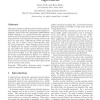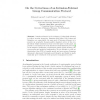119 search results - page 18 / 24 » Finite models for formal security proofs |
IJNSEC
2006
13 years 7 months ago
2006
This paper presents an efficient password-based authenticated encrypted group key agreement protocol immune to dictionary attack under the computation Diffie-Hellman (CDH) assumpt...
AMAST
2000
Springer
13 years 11 months ago
2000
Springer
The primary objective of this paper is to present the deÿnition of a new dynamic, linear and modal logic for security protocols. The logic is compact, expressive and formal. It a...
ASIACRYPT
2009
Springer
14 years 2 months ago
2009
Springer
Computational puzzles are mildly difficult computational problems that require resources (processor cycles, memory, or both) to solve. Puzzles have found a variety of uses in secu...
SP
2010
IEEE
13 years 5 months ago
2010
IEEE
The security of systems such as operating systems, hypervisors, and web browsers depend critically on reference monitors to correctly enforce their desired security policy in the ...
CHARME
2003
Springer
14 years 21 days ago
2003
Springer
Intrusion-tolerance is the technique of using fault-tolerance to achieve security properties. Assuming that faults, both benign and Byzantine, are unavoidable, the main goal of Int...


